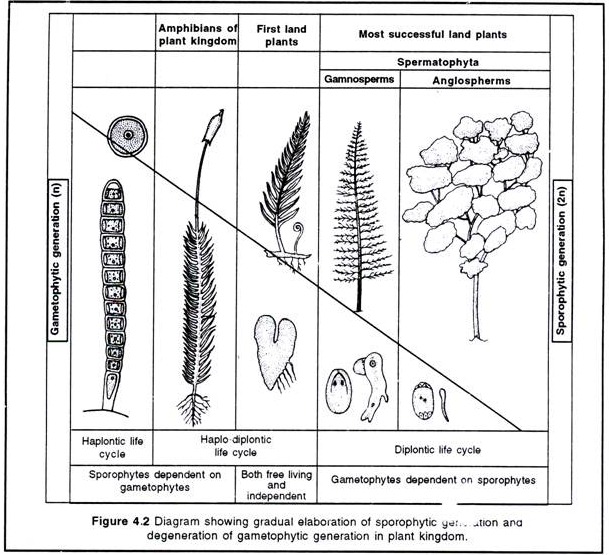ADVERTISEMENTS:
The life cycles of all sexually reproducing plants follow a pattern of alternation between a haploid, sexual generation called gametophyte with a diploid, asexual generation called sporophyte.
This phenomenon of alternation between gametophyte (n) and sporophyte (2n) in the life cycle of a plant is called alternation of generations (Hofmeister, 1851).
Alternation of generations is of two types- isomorphic and heteromorphy. In isomorphic (or homologous) type both the alternating generations are morphologically similar, while in heteromophic (or heterologous) type of alternation of generations both the generations of life cycle are morphologically dissimilar.
ADVERTISEMENTS:
In the life cycle, change of ploidy level from diploid (2n) to haploid (n) is brought about by meiosis and fertilization (syngamy) respectively. The sporophyte generation is “diploid” in which meiosis occurs to produce haploid spores, while gametophyte generation is “haploid” in which gametes are produced (by mitosis of haploid cells).
In the life cycle, any one of the two generations is found to be always more conspicuous and survive a greater proportion is called as dominant generation. In algae and bryophytes the somatic or vegetative plant body is a gametophyte which is dominant and visible. But in pteridophytes, gymnosperms and angiosperms the visible plant body is a sporophyte which is dominant and the gametophyte generation is less conspicuous (Fig. 4.2).
In the life cycle diagram, the dominant generation should be placed in the top half of the cycle. Plant life cycles differ from animal life cycles by adding a haploid gametophyte generation after meiosis and before the production of gametes.
ADVERTISEMENTS:
Types of Plant Life Cycles (Fig. 4.1):
In the life cycles of plants one or more morphologically distinct generations appear.
On this basis, life cycle may be three types:
(i) Uniphasic:
In this life cycle, only one visible generation is distinct either haploid or diploid and the life cycle are called haplontic, or diplontic.
(ii) Diphasic:
In this type, both the haploid and diploid generations are distinct. The life cycle is called haplo-diplontic or diplo-haplontic
(iii) Triphasic:
ADVERTISEMENTS:
In this case, three dissimilar generations are distinct, and accordingly, life cycle may be haplo-haplo-haplontic or diplo-diplo-haplontic type. Broadly speaking plant life cycles are of five types i.e. haplontic, diplontic, haplo-diplontic, haplobiontic (= haplo-haplontic) and diplobiontic (= diplo-diplo-haplontic).
It is the primitive type of life cycle characterized by dominant gametophyte and zygotic meiosis. Here, free-living sporophyte absent. The sporophyte generation is represented only by the one-celled zygote, sometimes called zygospore. The zygote undergoes meiosis to form haploid spores. Each spore germinates (divide mitotically) to form gametophyte. Haplontic life cycle found in many algae like Volvox, Spirogyra, Ulothrix, Chlamydomonas etc.
(b) Diplontic life cycle:
ADVERTISEMENTS:
The life cycle characterized by gametic meiosis and diploid sporophyte this is dominant, photosynthetic and independent generation of the plant. The gametophyte generation is represented by the haploid gametes or few celled haploid gametophyte. Here only sporophyte is conspicuous and gametophyte is inconspicuous. Diplontic life cycle is exhibited by some green algae, brown algae and all seed bearing plants i.e. gymnosperms and angiosperms. In seeded plants pollen and ovaries contain male and female gametophytes, respectively.
(c) Haplo-diplontic life cycle
This type of life cycle involves the alternation of two vegetative individuals, the haploid gametophyte and diploid sporophyte. In this case sporogenic meiosis occurs in sporophyte to produce spores (meiospores). Here both the generations are conspicuous. This type of life cycle is exhibited by some green algae, brown algae, bryophytes and pteridophytes.
(d) Haplobiontic (= haplo-haplontic) life cycle:
ADVERTISEMENTS:
It is also called diphasic-haplobiontic, where two successive vegetative phases are gametophytes that alternate with a diploid short-lived sporophyte, e.g. red algae like Nemalion, etc.
(e) Diplobiontic (= diplo-diplo-haplontic):
It is also called diphasic-diplobiontic, where two successive diploid phases alternate with the gametophyte.


